How to determine the right hangar classification and equipment according to NFPA
A fleet of five Navy attack F/A-18s is undergoing maintenance and modifications in a hangar in north Florida. Without warning, the airplane hangar fire suppression system is activated and discharges its high-expansion fire-retardant foam onto the aircraft below. At a cost that was initially estimated at more than $1 million, this will be classified as a “Class A” mishap by the Navy. The cause of activation remains undetermined.
Further south, a deluge system is activated inside of an aircraft manufacturing hangar. This activation is due to a faulty pull station that has gotten wet from high winds and rains. It causes damage to the fire protection and pump system and results in more than $200,000 worth of repairs and lost work time.
It’s stories like these that make owners and facility managers of aviation storage hesitant about the installation, purpose, and activation of airplane hangar fire suppression systems. However, false activations and mishaps can be minimized or eliminated when the proper system is installed and the required inspection, testing, and maintenance are conducted.
On the surface, these systems seem to be an unnecessary requirement. They do nothing to enhance or create income, add to the construction cost, require regular maintenance, and it may seem that they could cause more damage than benefit. However, when needed, airplane hangar fire suppression systems will prove their value many times over.
They are also required by NFPA 409: Standard on Aircraft Hangars – but not every aircraft hangar requires the same level of fire protection. The extent of water-based fire protection that is needed is based on the classification of the hangar: Group I, Group II, Group III, or Group IV, based on square footage of the largest fire area and the construction type. Reducing costs and ensuring system efficiency can be accomplished by the proper classification of the hangar and specifying the appropriate type of fire suppression system.
Fire suppression in Group I aircraft hangars
To be classified as Group I, the hangar must have either an aircraft access door over 28’ in height, a single fire area greater than 40,000 square feet, or be able to house an aircraft with a tail height of over 28’. Group I hangars have three fire suppression system options:
- A foam/water deluge system
- A combination of an automatic sprinkler system and a low-level low expansion foam system
- A combination of an automatic sprinkler system and a low-level high expansion foam system
If fire protection option 1 is used – a foam/water deluge system – in hangars housing aircraft with a wingspan area of greater than 3,000 square feet, supplemental protection is also required. Supplementary protection systems are designed to cover the area beneath the aircraft being protected. These typically consist of an automatic monitor nozzle that is tied into the building’s fire suppression system.
From the 2016 edition of NFPA 409
6.2.3.1* Hangars protected in accordance with 6.1.1(1) and housing aircraft having wing areas in excess of 279 m2 (3000 ft2) shall be protected with a listed supplementary protection system.
6.2.3.2* Each system shall be designed to cover a specified floor area beneath the aircraft being protected. The design objective shall be to achieve control of the fire within the protected area within 30 seconds of system actuation and extinguishment of the fire within 60 seconds.
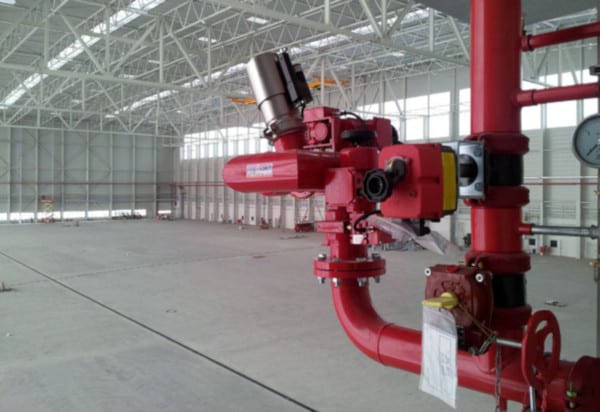
For Group I hangars that will house only unfueled aircraft, a simple wet-pipe automatic sprinkler system or a single-interlock preaction sprinkler system is permitted. To be considered unfueled, the aircraft must meet the definition specified by NFPA:
From the 2016 edition of NFPA 409
3.3.15* Unfueled Aircraft. An aircraft whose fuel system has had flammable or combustible liquid removed such that no tank, cell, or piping contains more than one-half of 1 percent of its volumetric capacity.
Stand-alone hand hose or foam-water stations are required within the aircraft storage area. Hose stations and standpipes are required to be installed within the non-aircraft areas of the building.
From the 2016 edition of NFPA 409
6.2.9.1 Hand hose systems shall be installed in every hangar to provide for manual fire control.
6.2.9.2 The hand hose systems shall be arranged to permit application of water or other extinguishing agents on each side and into the interior of the aircraft located in each aircraft storage and servicing area. At least two hose lines shall be designed to be operated simultaneously.
Fire suppression in Group II aircraft hangars
To be classified as Group II, the aircraft hangar must have an aircraft access door height of 28’ or less, and a single fire area less than 40,000 square feet based on construction type, as listed in Table 4.1.2:
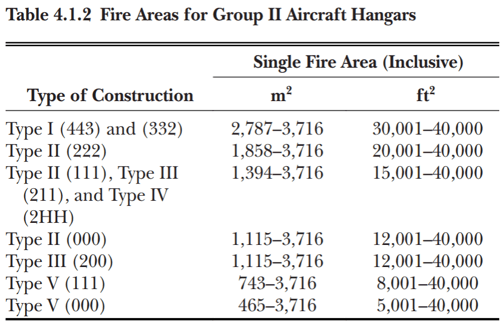
A Group II aircraft hangar can be protected using any of the options for Group I, however the system must meet adjusted design criteria for Group II hangars – specific gallons per minute/square feet and/or sprinkler response temperatures – as stated in NFPA 409, Chapter 7. The additional protection option of using a closed head foam/water system is also permitted in Group II hangars. The same requirements for unfueled aircraft and hand-hose stations apply.
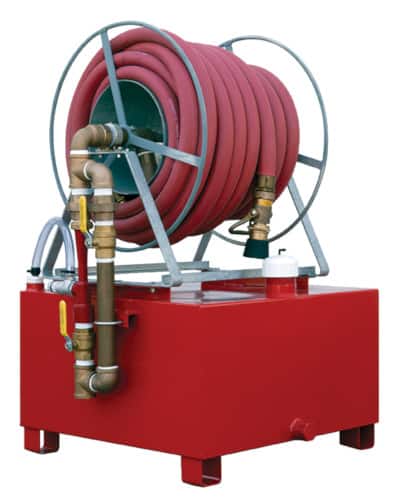
Fire protection in Group III aircraft hangars
To be classified as Group III, the aircraft hangar must have an access door height of 28’ or less and a single fire area less than 30,000 square feet:
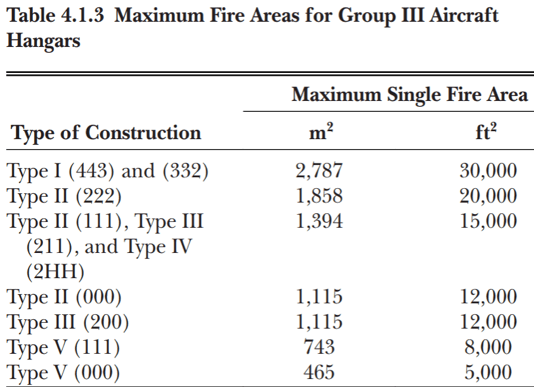
A Group III aircraft hangar does not automatically require a fire suppression system, and one may be permitted to be omitted. However, fire protection is required under the following conditions:
- Where required by the AHJ, as based on the adopted building codes of the jurisdiction.
- Where hazardous operations are performed.
NFPA 409 describes what constitutes a hazardous operation:
From the 2016 edition of NFPA 409
8.8.1.2* In addition to the requirement of 8.8.1.1, where hazardous operations, including fuel transfer, welding, torch cutting, torch soldering, doping, and spray painting, are performed in any Group III hangar, the Group III hangar shall be protected with the fire protection specified in Chapter 7 and also shall meet the requirements specified in 5.4.2.
When a Group III classified aircraft hangar requires a fire protection system, a system utilizing the options and meeting the requirements for a Group II hangar shall be utilized.
Fire protection in Group IV aircraft hangars
Any membrane-covered, rigid-steel frame structure used for the storage or servicing of aircraft is classified as a Group IV hangar. For these hangars, there are three configurations which have different fire protection system requirements:
- Greater than 12,000 square feet housing fueled aircraft
- Greater than 12,000 square feet housing unfueled aircraft
- Hangars smaller than 12,000 square feet
For Group IV hangars greater than 12,000 square feet that house fueled aircraft, the following fire protection systems are required:
- A low-level low expansion foam system with a foam/water hand-hose station
- A low-level high expansion foam system with a foam/water hand-hose station
For Group IV hangars greater than 12,000 square feet that house unfueled aircraft, either of the options for fueled aircraft can be used or a closed-head sprinkler system (wet or pre-action) can be utilized. A hose station and standpipe system are required in the aircraft storage and servicing areas.
Those Group IV hangars that are less than 12,000 square feet must meet fire protection requirements comparable to the requirements for Group III hangars. Systems are not automatically required and may be omitted, unless they are required by the AHJ or hazardous operations are performed within the hangar.
If a system is required, it can be a simple automatic sprinkler system installed in accordance with NFPA 13: Standard for the Installation of Sprinkler Systems. Hose and standpipe systems are required in all non-aircraft areas.
From the 2016 edition of NFPA 409
9.14.11.4.1 Water hand hose and standpipe systems shall be installed in accordance with NFPA 14 in aircraft storage and servicing areas having a hangar fire area greater than 1,115 m2 (12,000 ft2) and housing unfueled aircraft and all shop, office, and non-aircraft storage areas in hangars, except where special hazards that require special protection exist.
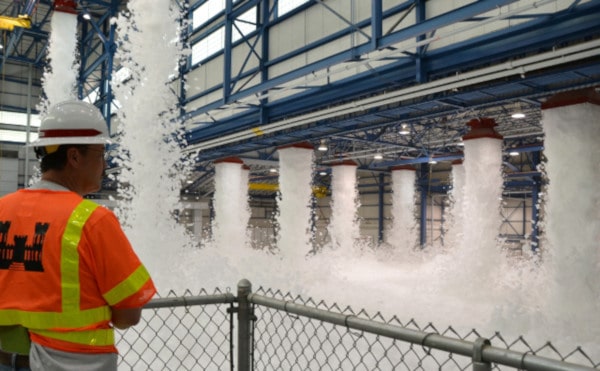
Peace of mind that you’re protecting aviation assets can be had by ensuring that the proper type of system is installed and all inspection, testing, and maintenance requirements are completed.
If you need common water-based fire protection components for your aviation system, such as tamper switches, flow switches, alarm bells, valves, fire hose reels, and more, check out QRFS’s online selection.
If you require specific components for foam systems, call us at 888-361-6662, email support@QRFS.com, or fill out our contact form to discuss your options.



Hi
We are looking at building a hangar of 10000 Metre square.
We would like to have a quotation for the equipment covering this area.
Regards
Valentine
Valentine, thanks for reaching out! We will have our Customer Support Team reach out. You can always reach us at 888-361-6662 or support@qrfs.com.
Thanks to the author for sharing such a great post. The article was very well written and providing about #139- Airplane hangar fire suppression systems: an essential guide. It can be really great for people like me who are looking for grabbing more knowledge about it.
Trying to decide to build 1 30,000 sq ft or 2 12,000 sq ft hangars at KIXD johnson county ,ks
28ft door.
913-768-9400
Robert — If your question involves making a decision based on the fire suppression requirements in codes and standards, you can try our Ask a Fire Pro service. Click the link to submit your question with some information about your building or system, and a fire protection professional will provide an answer based on standards and codes. Our pros include AHJs, contractors, engineers, and code experts with 150+ years of combined experience!
In a system that is composed of ordinary sprinklers under the roof and high expansion foam generators below the roof, would it be advisable to use flowswitch of the sprinkler system to operate via the FACP the foam system as well?
The Foam system is initiated by flame detectors in addition to the aforesaid Flow switch.
Dan — Unfortunately, we cannot comment on complex design considerations in this format. We suggest you consult a fire protection designer/engineer to review your question. Thanks for reading.